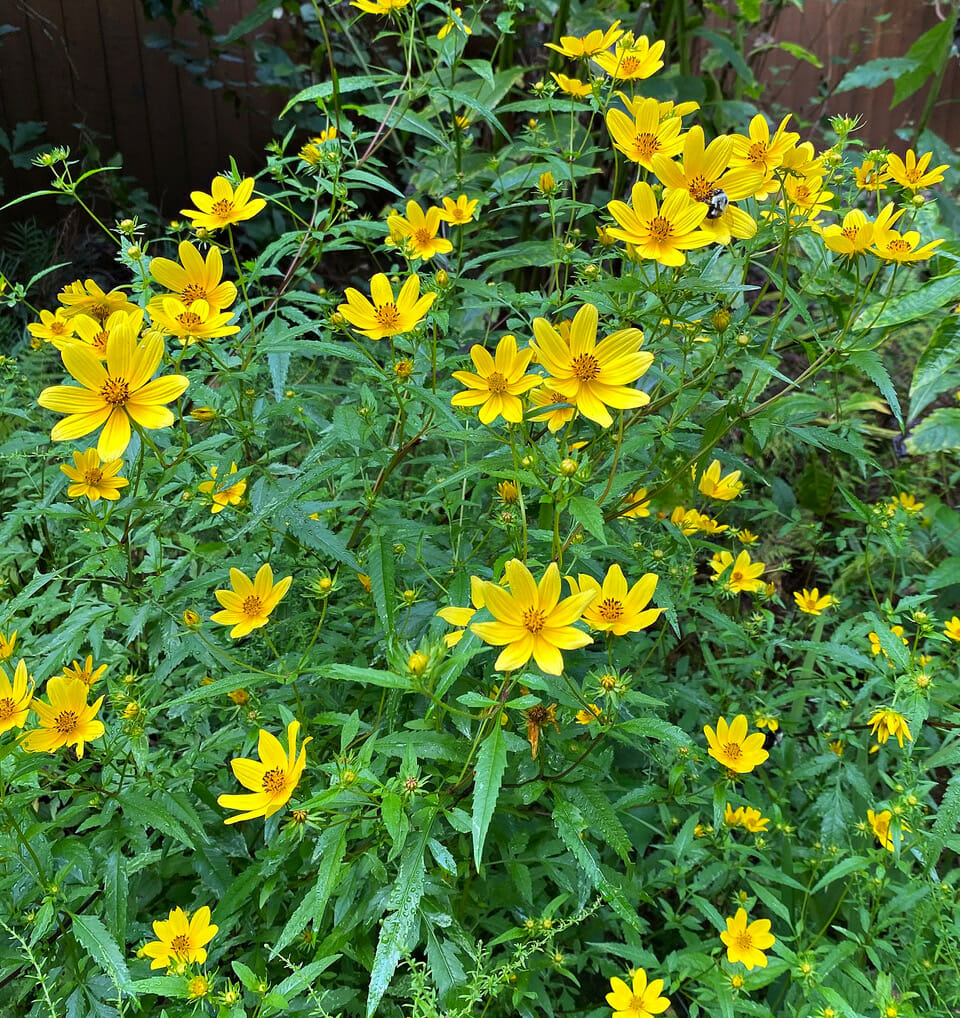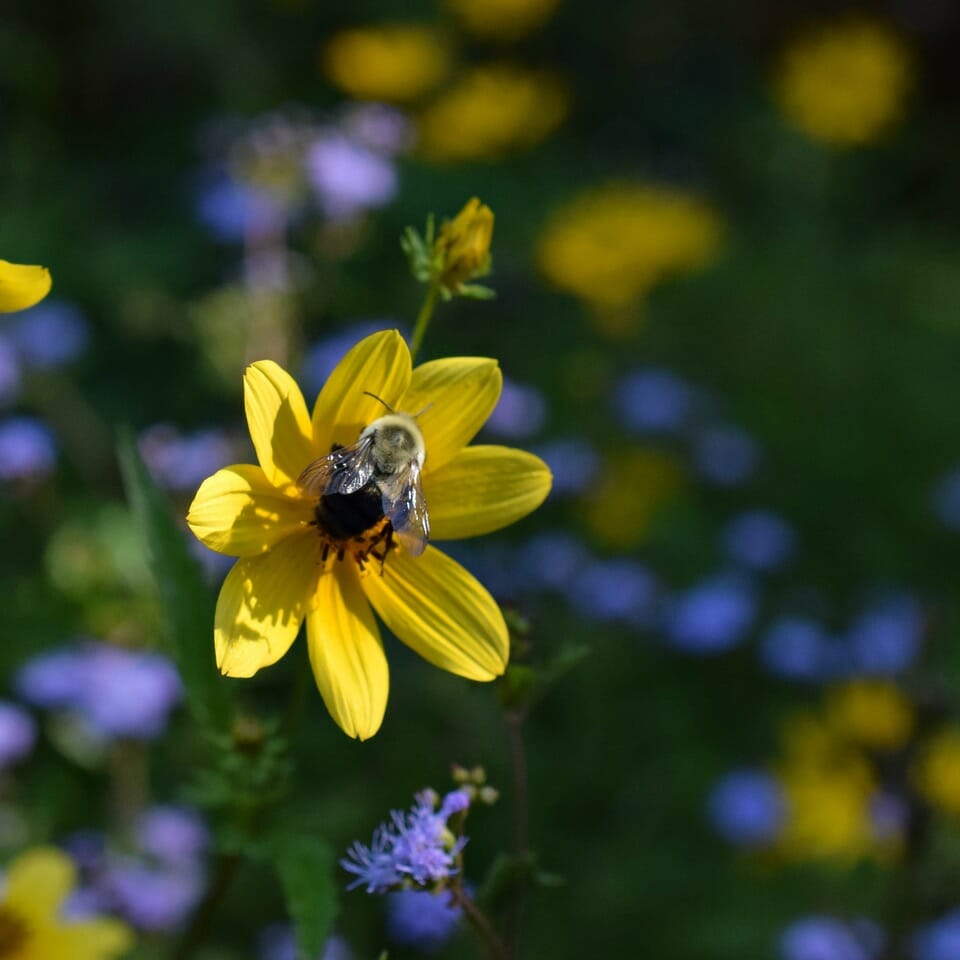Vote for the GNPS 2022 Plant of the Year!
Each year, we celebrate one special native plant by selecting it as GNPS Plant of the Year (POY). The six nominated plants are featured below. POY online voting is EASY. Just go to the voting page*, click to make your selection, and press “Submit.” (If you are not already logged in, you will be prompted to do so before the voting page appears. If it does not appear immediately after logging in, come back here and click that voting page link again.) Online voting will remain open until November 30th. The last few years have seen some really close contests, with only a few votes separating the winner from the runner up. YOUR VOTE MATTERS! So get in there and pick the plant you think is best for POY 2022!
*If the link to the voting page above doesn’t work for you, try copying this in your browser: https://gnps.app.neoncrm.com/survey.jsp?surveyId=17&. You will have to log in as a member, and after doing so, it may be easiest just to click on the link again (or copy into your browser again).
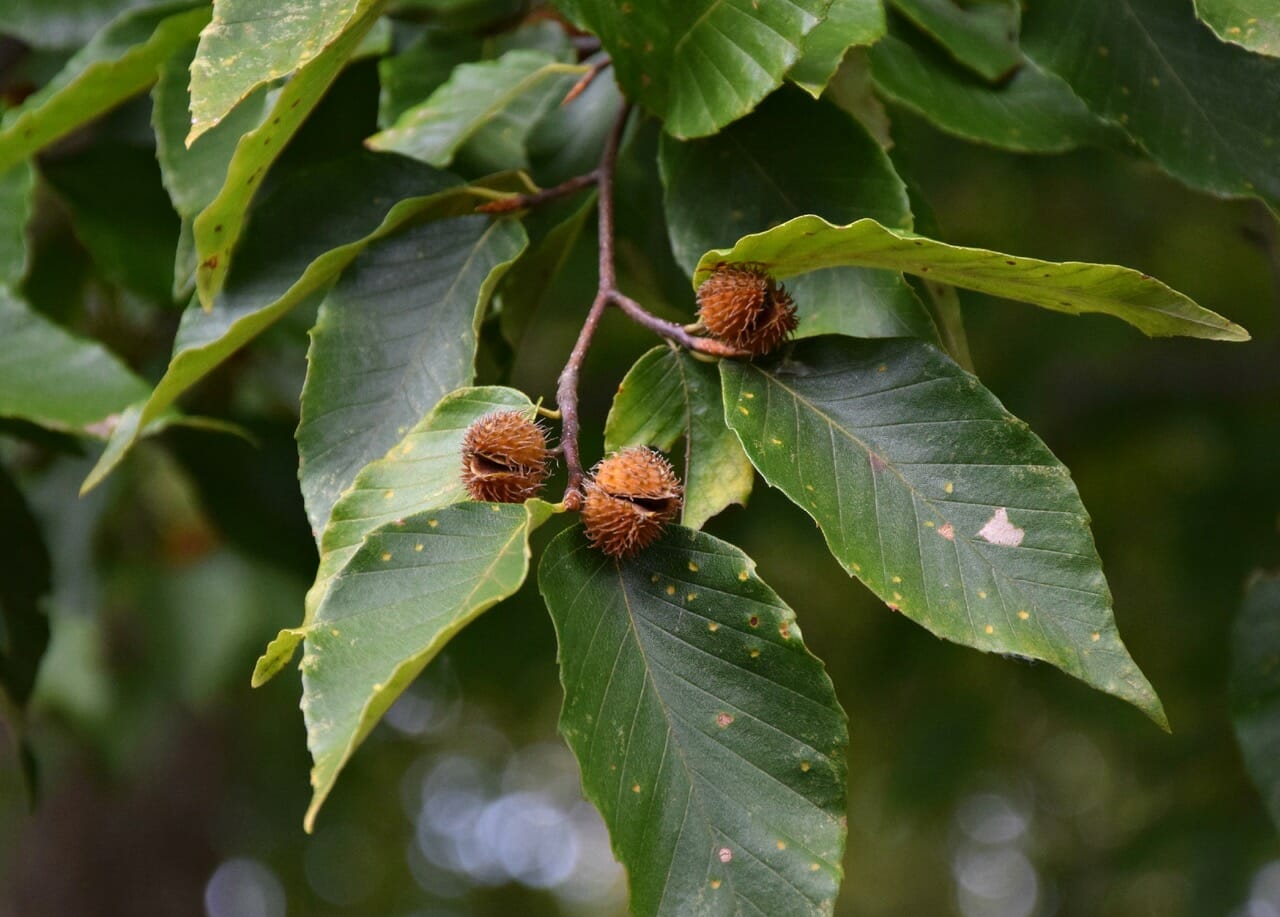

American beech
Scientific name: Fagus grandifolia
Common names: American beech
Family: Fagaceae
Plant type: Tree
The American beech (Fagus grandifolia) is a majestic deciduous shade tree with wide branches and signature “elephant skin” bark, a seemingly irresistible canvas for those who would leave a trace of their passing. Who hasn’t walked past a beech tree in a public space and seen initials or messages carved into its smooth grey trunk? Beech trees reach 60-100’ tall, with crowns spreading up to 80’ wide. Their simple, alternate leaves are typically 3-5” long and half as wide, ovoid or elliptical, and coarsely toothed, with alternate, parallel veins. Glossy medium green on top, smooth and lighter colored underneath in the growing season, the leaves turn yellow in autumn and then golden beige in winter, finally falling off in spring. Individual beech trees have both male flowers (catkins) and small, paired female flowers. Female flowers convert to spiky husks, each roughly thumbnail sized and containing an edible three-sided nut. Animals love the nuts, as they are highly nutritious. (Note: Beech nuts should be roasted before eating in quantity, as they are slightly toxic to humans when raw). In nature, beech trees can be found in moist mountain coves or well-drained acidic bottomlands. They prefer sun or partial shade, and do not like compacted or wet soils. American beeches make excellent specimen trees for large spaces, but are not recommended for small gardens.
Credits: Text by Valerie Boss. Photos by Ellen Honeycutt.


Downy ragged goldenrod
Scientific name: Solidago petiolaris
Common names: Downy ragged goldenrod; downy goldenrod
Family: Asteraceae
Plant type: Perennial
Over a hundred insect species–flies, native bees, honeybees, butterflies and moths–feed on goldenrods, genus Solidago. For pollinator gardens, downy ragged goldenrod (Solidago petiolaris) is an ideal species. It is hardy, blooms profusely from August through October, stays fairly short, and doesn’t spread aggressively. Downy ragged goldenrod aka downy goldenrod (not to be confused with S. puberula, which shares that common name) reaches 1-4’ tall, with either single or multiple leafy, unbranched stems. The leaves are alternate, medium green, and narrowly ellipsoid in shape, ranging from 1-5” long, and gradually reducing in size as they ascend the stem. In autumn, each stem is topped by a loose panicle, 4-10” long, of up to 150 bright yellow flowerheads. The flowers (each about ¼” long) tend to be spaced evenly along the stem, either as individual blossoms or in small clusters. However, if a stem sprawls rather than remaining erect, the flowers will twist so that they all face the sunlight. Flowers are comprised of disk and ray florets, both of the same vivid yellow color. When they go to seed, the seed heads are tufted like those of dandelions and are similarly wind dispersed. Downy ragged goldenrod grows in open woodlands, meadows, and rocky areas. It likes dry, sunny areas, and will tolerate almost any soil type.
Credits: Text by Valerie Boss. Photos by Ellen Honeycutt.
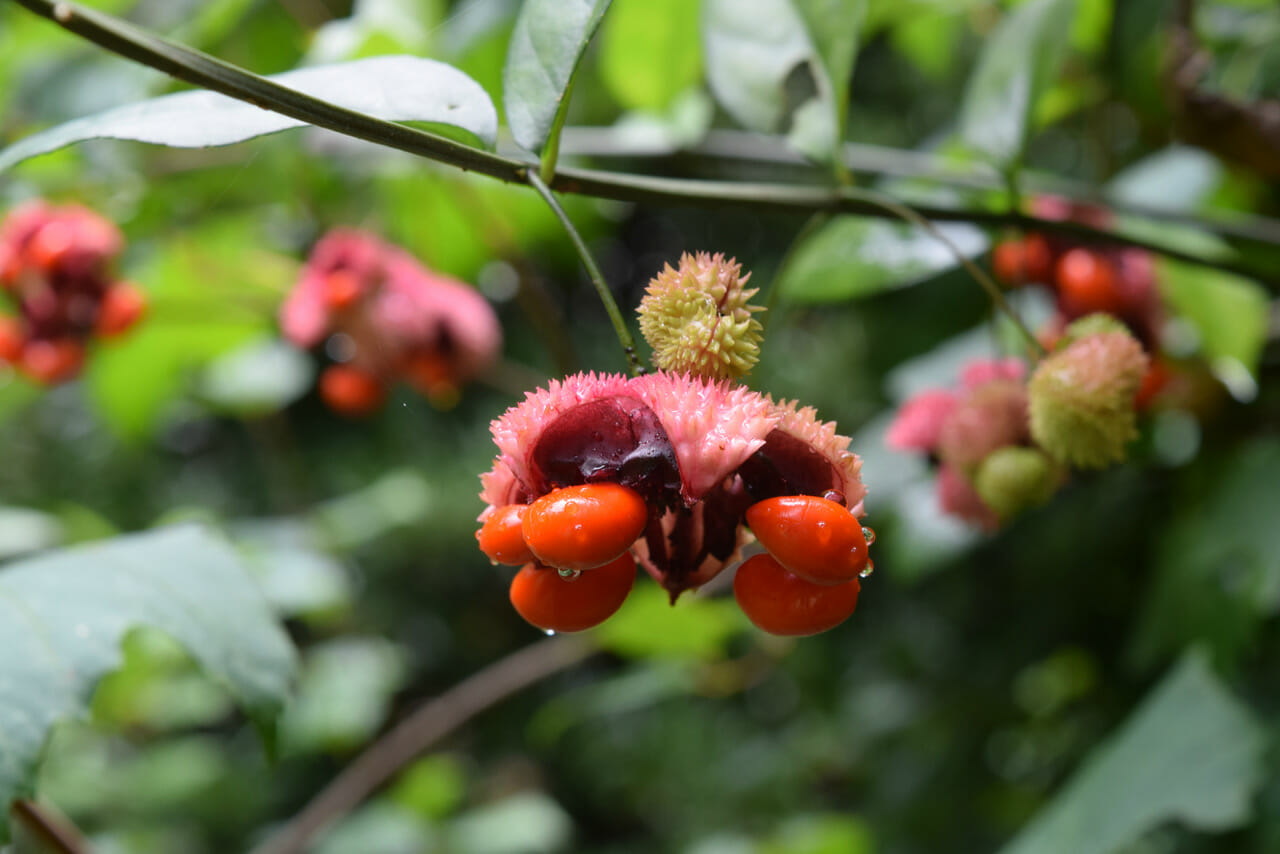
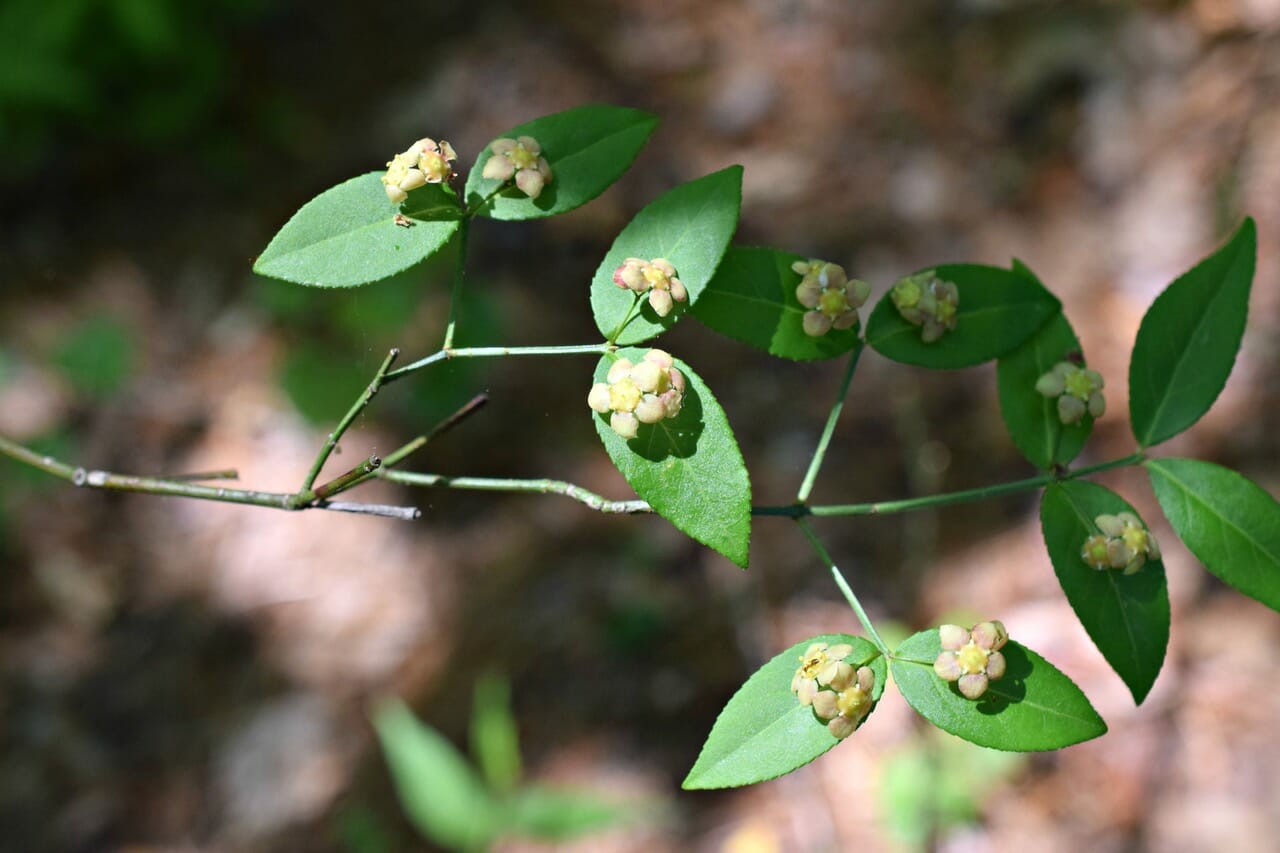
Hearts-a-bustin’
Scientific name: Euonymus americanus
Common names: Hearts-a-bustin’: strawberry bush; American strawberry bush
Family: Celastraceae
Plant type: Shrub
Hearts-a-bustin’ (Euonymus americanus) is an open, sprawling understory shrub. Its multiple dark green or purplish-green stems grow to about 6’ in length. They tilt over when young, but become more erect and woody with age. Opposite fine, square-edged branches stick out stiffly from the main stems, each bearing a terminal pair of deciduous leaves. The leaves are 2-5” long, ovate or lanceolate, with pointed tips. In spring, the species exhibits modest little greenish-yellow flowers that grow on short stalks above the leaves. Although this plant isn’t a remarkable bloomer, it certainly puts on a show in the fall. In September and October, when the leaves are still green, unusual red seed pods resembling warty strawberries (albeit poisonous ones) rupture to reveal 4 brilliant vermillion seeds that feed the birds throughout the winter. The seed pods give the plant its common names, strawberry bush and heats-a-bustin’. As winter nears, the leaves turn red, adding to its late season interest. Hearts-a-bustin’ is easy to grow and tends to sucker, which also makes it simple to propagate. Naturally growing in woodlands, it likes partial shade and is hardy in most soils. The species is low maintenance once established, but not deer resistant.
Credits: Text by Valerie Boss. Photos by Ellen Honeycutt.
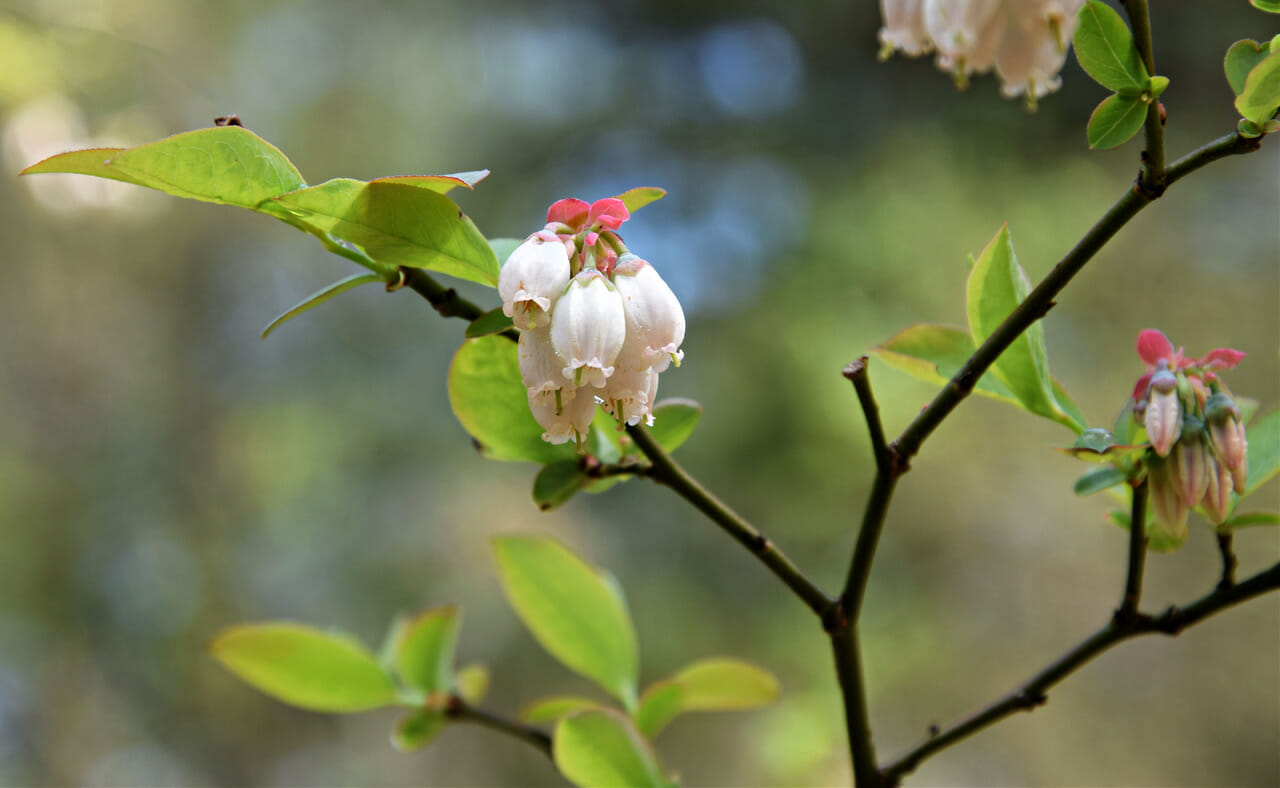
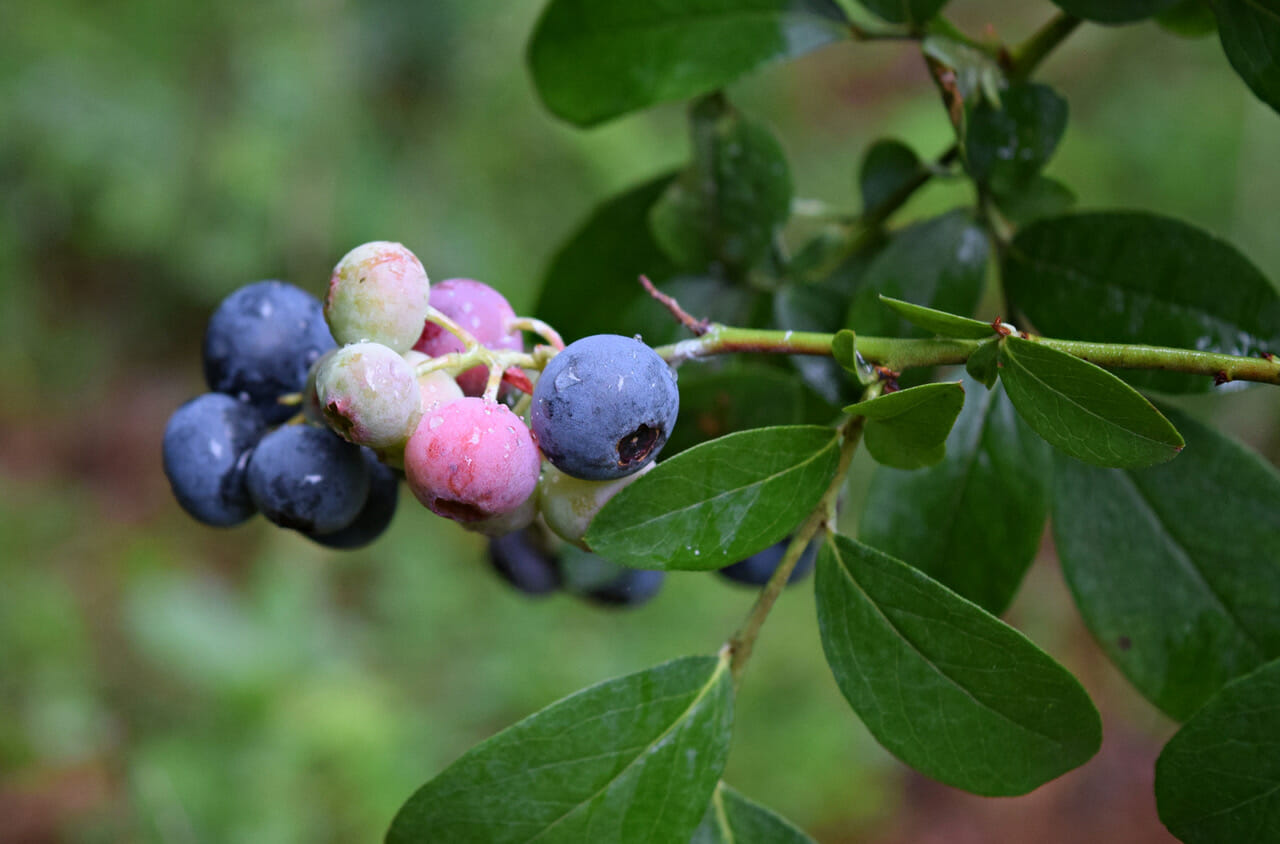
Rabbiteye blueberry
Scientific name: Vaccinium virgatum (formerly V. ashei)
Common names: Rabbiteye blueberry
Family: Ericaceae
Plant type: Shrub
The rabbiteye blueberry (Vaccinium virgatum) is a deciduous shrub with delicious fruit. Genetic studies suggest that it developed from natural hybridization of the coastal small black blueberry, V. tenellum, with other native species. Native blueberries continue to cross hybridize and as a consequence, wild populations of rabbiteye blueberries can have different growth habits and berry characteristics. In general, the species grows to about 3-6’ in height and 3’ wide. The leaves are 1-3” long, alternate, elliptical, red in early spring, dark green or blue-green in summer (with lighter undersides), and red or burgundy in the fall. Spring flowers look like clusters of white or pinkish-white bells, and are pollinated by native bees. When fruits first appear, they are pink and resemble the eyes of white rabbits; hence the common name. Ripe fruits are dark blue to almost black. Rabbiteye blueberries make beautiful hedge plants, and are also a good choice for wetland gardens. Their native habitats include swamps, pond or stream banks, upland woods, and pine barrens. They require acidic soil and don’t like clay, but are heat tolerant and generally hardy. Many cultivars are available. They are self-infertile, and more than one cultivar is necessary to produce fruit. Birds and bears love the berries, as do humans.
Credits: Text by Valerie Boss. Photos by Ellen Honeycutt.
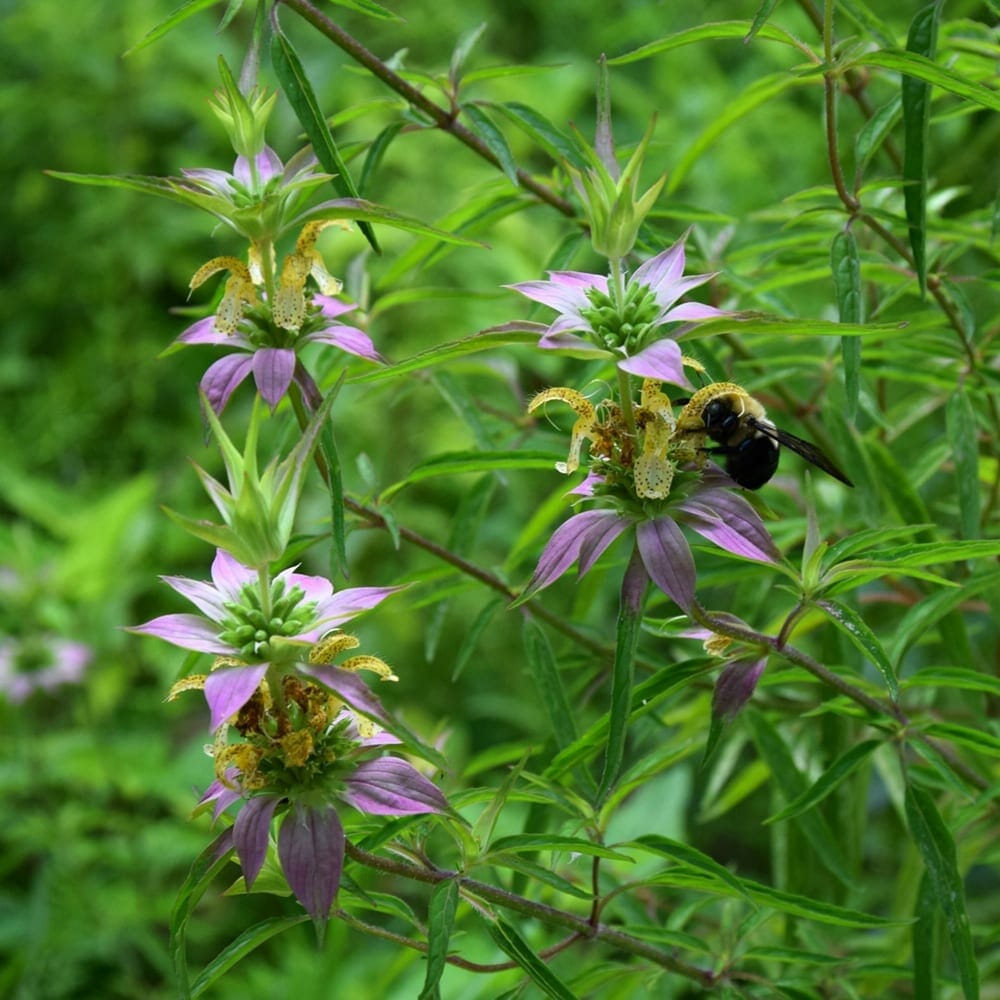

Spotted beebalm
Scientific name: Monarda punctata
Common name: Spotted beebalm; spotted horsemint
Family: Lamiaceae
Plant type: Perennial
Spotted beebalm (Monarda punctata) grows in dry, sandy soils, and is found in woodland margins and coastal plains. It is easily cultivated and makes a wonderful garden plant. Its stems (2-3’ tall) are square, either simple or branched, and covered with soft hairs. Opposite leaves grow to about 3” long, and are lanceolate, toothed, and hairy. They are also highly aromatic, containing thymol, a compound also found in oregano. In summer, its showy flower heads are confections of whorled bracts and domes of under-curling, purplish-dotted yellow petals. The inflorescence pattern of the species is unusual: flower heads, each about 1” around, are stacked—one at the stem tip, and those below it encircling the stem. Bracts beneath the petal domes are pinkish-purple, and a bright green whorl of bracts crowns the terminal flower head. Spotted beebalm is a source of pollen and nectar for numerous bees, as well as wasps, sphinx moths and various butterflies. Like many other members of the mint family, spotted beebalm is medicinal. The leaves may be used in teas to treat fever, aches and inflammation, and the essential oil has antibacterial properties.
Credits: Text by Valerie Boss. Photos by Ellen Honeycutt and Valerie Boss.
Bearded beggarticks
Scientific name: Bidens aristosa
Common names: Bearded beggarticks; tickseed beggarticks; long-bracted beggarticks; tickseed sunflower; bur marigold
Family: Asteraceae
Plant type: Annual
From August through October, Bidens aristosa, commonly known as bearded beggarticks, is like a burst of floral sunshine. Individual plants can reach 2-4’ high and about half as wide. Their leaves are opposite and pinnately or bi-pinnately compound with sharply toothed edges. Their stems are slender, leafy and branched, with each branch bearing multiple 1-2” yellow, daisy-like flowers. These copious blooms are followed by equally copious seed-like fruits. Known as “beggar’s ticks”, they are flat achenes with two terminal prongs, and they latch on to anything or anyone that brushes by. The natural habitats of bearded beggarticks are wet meadows, roadside ditches and areas of disturbed soil. In gardens, this hardy and somewhat deer-resistant species is adaptable to most soil types, except sand. The plant likes full sun, but can tolerate partial shade. Like many heavily blooming annuals, it likes to spread. If it gets too weedy in the garden, the flowers may need to be deadheaded to prevent seed dispersal. Bearded beggarticks is beneficial to wildlife. Its nectar feeds numerous bees and butterflies, and its many seeds provide nutrition for ducks and songbirds.
Credits: Text by Valerie Boss. Photos by Ellen Honeycutt.

